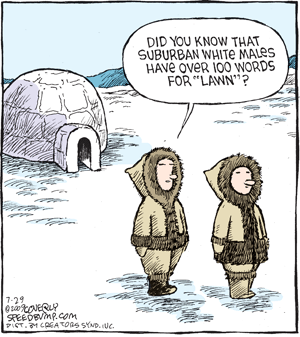
It led to the following discussion:
Pop-Whorfianism in the comics again
July 29, 2009 @ 11:12 am
Would you resolve for me the contradictory information I have encountered regarding the size of the Inuit vocabulary related to solid water in its many forms? I have read claims that it is in fact larger than similar vocabularies for temperate-zone peoples, and I have read claims that it is no larger than such vocabularies. I am willing to bet that it's larger than the similar vocabularies for Amazon basin languages. Indeed, it might be interesting to prepare a scatter diagram showing size of this vocabulary on the vertical and latitude of the language group on the horizontal; I would expect (with an exception for high-altitude languages) a positive correlation.
In any event, what are the facts of the matter?
Bobbie said,
July 29, 2009 @ 11:26 am
I think Chris is missing the point of the joke. It's not about quantification and the actual size of the Inuit vocabulary. It's about the large corpus of mythology that seems to have sprung up about those estimates of words for snow.
I am sure there are more words for solid water in the Inuit language than there are for Amazon basin cultures…. and more words for poisonous animals and plants in the Amazon vocabularies…. But the laughable part is the perpetuation of the supposed "facts" and the widespread assumption that those "facts" are true.
That does not mean there are huge numbers of unrelated basic terms for huge numbers of finely differentiated snow types. It means that the notion of fixing a number of snow words, or even a definition of what a word for snow would be, is meaningless for these languages. You could write down not just thousands but millions of words built from roots that refer to snow if you had the time. But they would all be derivatives of a fairly small number of roots. And you could write down just as many derivatives of any other root: fish, or coffee, or excrement.
Even though the Speed Bump cartoon makes fun of "suburban white males," it uses common Eskimo stereotypes. I'm not sure what cartoonists such as Speed Bump's Dave Coverly are thinking. That Eskimos are so remote, primitive, and illiterate that such cartoons won't offend them? Or that most Eskimos really look and live like this?

3 comments:
I'm sure that he's thinking shorthand -- if he depicted modern looking people, his audience wouldn't immediately guess that they were Eskimos. Shortcuts like that are both what makes comics, particularly joke comics, work -- and one of the problems with how comics reinforce stereotypes.
Scott McCloud's Understanding Comics doesn't address the issue directly, but does touch on the idea of boiling down images to be instantly recognizable to your audience.
Love the grammar lesson. It's easy to start a linguistic misunderstanding (and the following "truism") when you miss out on the important grammar rules.
I know cartoonists use Eskimos and Indian chiefs and "braves" as shorthand. The question is whether we should accept this.
A comparable stereotype would be a black African in a loincloth with a ring through his nose, or a "Chinaman" in a coolie outfit with a conical hat. People would protest loudly if cartoonists used these stereotypes regularly, but the same people think Native stereotypes are okay.
It's a good point. The old Asian stereotypes have mostly disappeared from comics also. The difference might be that cartoonists are still using Native American caricatures to make fun of mainstream American culture -- and that poking fun at suburban white men requires a group to provide the commentary. So maybe you're right in your entry -- maybe the idea is to pick a group that just won't put up a fuss and continue to use their stereotyped image. :(
Post a Comment